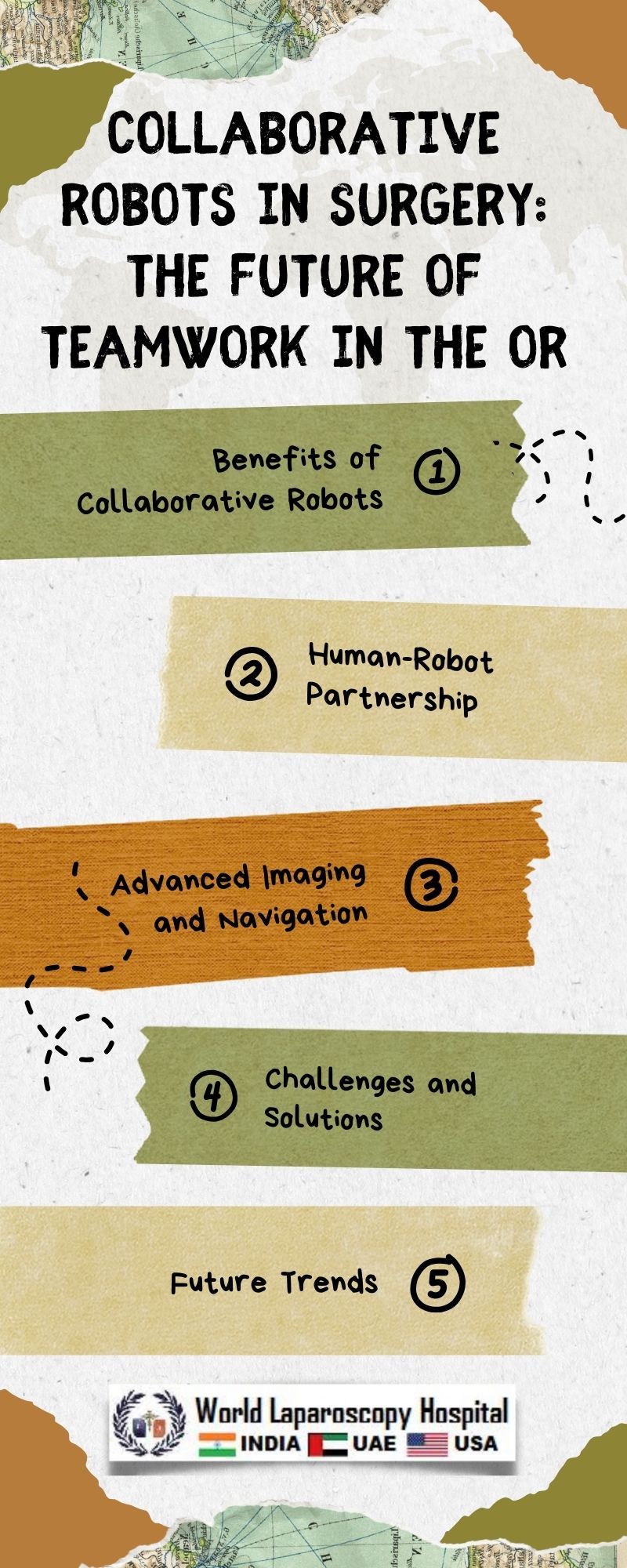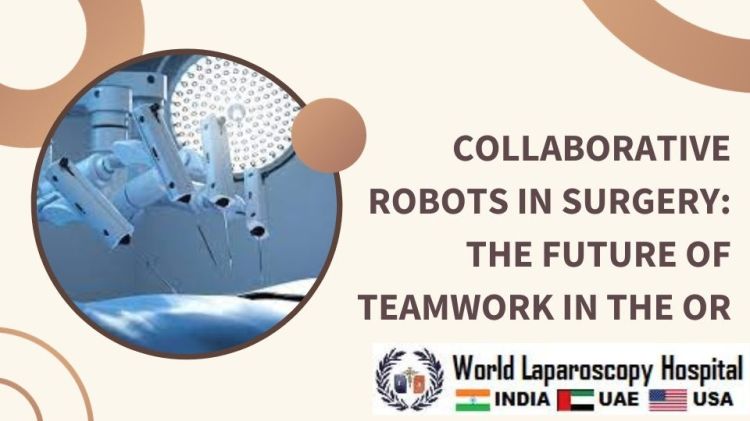Collaborative Robots in Surgery: The Future of Teamwork in the OR
Collaborative Robots in Surgery: The Future of Teamwork in the OR
Introduction:
The field of surgery is experiencing a transformative shift with the integration of collaborative robots, or cobots, into the operating room (OR). These advanced robotic systems, designed to work alongside human surgeons, are reshaping the landscape of surgical procedures and setting the stage for a future where teamwork between humans and robots becomes the norm.

The Evolution of Surgical Robotics:
The journey towards collaborative robots in surgery can be traced back to the advent of traditional robotic-assisted surgery. The da Vinci Surgical System, introduced in the early 2000s, marked a significant milestone. It allowed surgeons to perform minimally invasive procedures with enhanced precision and control through robotic arms controlled by a console.
However, the paradigm is shifting from mere assistance to true collaboration. Collaborative robots, equipped with advanced sensors and artificial intelligence, are taking on more active roles in surgeries, promising a new era of teamwork in the OR.
The Rise of Collaborative Robots:
Collaborative robots are characterized by their ability to work alongside human surgeons in a shared workspace. Unlike their predecessors, these robots are designed to be inherently safe and responsive, adapting to the dynamic environment of the operating room. This shift is fueled by advancements in robotics, artificial intelligence, and machine learning.
Safety in Collaboration:
One of the key features of collaborative robots is their focus on safety. These robots are equipped with sensors and vision systems that allow them to detect and respond to human presence in real-time. This ensures that they can operate in close proximity to surgeons without posing a risk to their safety, thereby fostering a collaborative and trusting environment.
Enhanced Precision and Control:
Collaborative robots bring a new level of precision to surgical procedures. With their dexterity and accuracy, these robots can assist in intricate tasks, such as suturing and tissue manipulation, with unparalleled control. Surgeons can leverage the robotic capabilities to execute procedures with greater accuracy, leading to improved patient outcomes.
Applications in Surgical Specialties:
The integration of collaborative robots is not limited to a specific surgical specialty; rather, it spans across various disciplines, enhancing the capabilities of surgeons in different fields.
Orthopedic Surgery:
In orthopedic surgery, where precision is crucial, collaborative robots play a vital role. These robots assist in joint replacement surgeries, ensuring accurate placement of implants and optimizing the overall procedure. The combination of human expertise and robotic precision leads to faster recovery times and improved patient satisfaction.
Neurosurgery:
Neurosurgery demands the utmost precision due to the sensitivity of the nervous system. Collaborative robots in neurosurgery assist in tasks such as tumor removal and intricate procedures, providing surgeons with the tools to navigate complex anatomical structures with enhanced accuracy and reduced risk.
Cardiovascular Surgery:
Collaborative robots are making strides in cardiovascular surgery by assisting in procedures such as coronary artery bypass surgery and valve replacements. The ability to work in tight spaces and perform delicate maneuvers makes these robots invaluable assets in the cardiac operating room.
Human-Robot Collaboration: The Key to Success:
The success of collaborative robots in surgery lies in the seamless integration of human and machine capabilities. Surgeons and robotic systems work together in a synergistic fashion, each complementing the strengths of the other.
Training and Skill Enhancement:
As collaborative robots become more prevalent in the OR, there is a growing need for specialized training programs. Surgeons are acquiring new skills to effectively collaborate with these robotic systems, understanding their capabilities and leveraging them to enhance their own expertise. Training programs focus not only on the technical aspects of robot-assisted surgery but also on fostering effective communication and collaboration in the surgical team.
Augmented Intelligence:
Collaborative robots bring a form of augmented intelligence to the operating room. Their ability to process vast amounts of data in real-time and provide insights to surgeons during procedures is reshaping decision-making processes. This collaboration between human intuition and robotic intelligence ensures that the final decisions are informed, precise, and optimized for the best possible outcomes.
Overcoming Challenges:
While the integration of collaborative robots in surgery holds immense promise, it is not without challenges. Addressing these challenges is essential for the widespread adoption of this transformative technology.
Cost and Accessibility:
The initial cost of acquiring and implementing collaborative robotic systems can be a barrier for many healthcare institutions. Additionally, ongoing maintenance and training costs contribute to the overall financial considerations. Efforts are being made to make these technologies more accessible, with advancements in affordability and scalability.
Regulatory Considerations:
The regulatory landscape for surgical robotics is evolving, with authorities working to establish guidelines for the safe and effective use of collaborative robots. Striking the right balance between innovation and patient safety is crucial, and regulatory bodies are actively engaging with industry stakeholders to develop comprehensive standards.
Future Outlook:
The trajectory of collaborative robots in surgery points towards a future where human-robot collaboration becomes standard practice. As technology continues to evolve, the capabilities of these robots will expand, ushering in new possibilities for surgical interventions.
Integration with Emerging Technologies:
Collaborative robots are likely to integrate with other emerging technologies, such as augmented reality (AR) and virtual reality (VR). This integration could provide surgeons with immersive visualizations and real-time data overlays, enhancing their situational awareness and decision-making.
Remote Surgery and Telepresence:
The advancement of communication technologies may pave the way for remote surgery, where surgeons can operate on patients located in different geographical locations. Collaborative robots, with their precise movements and haptic feedback capabilities, could enable surgeons to perform procedures from a distance, expanding access to specialized care.
Conclusion:
Collaborative robots are reshaping the landscape of surgery, offering a glimpse into the future of teamwork in the operating room. As technology continues to advance and challenges are addressed, the integration of collaborative robots will likely become more widespread. Surgeons, patients, and healthcare institutions stand to benefit from the enhanced precision, safety, and efficiency that collaborative robots bring to the world of surgery, marking a revolutionary chapter in medical history.
Top
Introduction:
The field of surgery is experiencing a transformative shift with the integration of collaborative robots, or cobots, into the operating room (OR). These advanced robotic systems, designed to work alongside human surgeons, are reshaping the landscape of surgical procedures and setting the stage for a future where teamwork between humans and robots becomes the norm.

The Evolution of Surgical Robotics:
The journey towards collaborative robots in surgery can be traced back to the advent of traditional robotic-assisted surgery. The da Vinci Surgical System, introduced in the early 2000s, marked a significant milestone. It allowed surgeons to perform minimally invasive procedures with enhanced precision and control through robotic arms controlled by a console.
However, the paradigm is shifting from mere assistance to true collaboration. Collaborative robots, equipped with advanced sensors and artificial intelligence, are taking on more active roles in surgeries, promising a new era of teamwork in the OR.
The Rise of Collaborative Robots:
Collaborative robots are characterized by their ability to work alongside human surgeons in a shared workspace. Unlike their predecessors, these robots are designed to be inherently safe and responsive, adapting to the dynamic environment of the operating room. This shift is fueled by advancements in robotics, artificial intelligence, and machine learning.
Safety in Collaboration:
One of the key features of collaborative robots is their focus on safety. These robots are equipped with sensors and vision systems that allow them to detect and respond to human presence in real-time. This ensures that they can operate in close proximity to surgeons without posing a risk to their safety, thereby fostering a collaborative and trusting environment.
Enhanced Precision and Control:
Collaborative robots bring a new level of precision to surgical procedures. With their dexterity and accuracy, these robots can assist in intricate tasks, such as suturing and tissue manipulation, with unparalleled control. Surgeons can leverage the robotic capabilities to execute procedures with greater accuracy, leading to improved patient outcomes.
Applications in Surgical Specialties:
The integration of collaborative robots is not limited to a specific surgical specialty; rather, it spans across various disciplines, enhancing the capabilities of surgeons in different fields.
Orthopedic Surgery:
In orthopedic surgery, where precision is crucial, collaborative robots play a vital role. These robots assist in joint replacement surgeries, ensuring accurate placement of implants and optimizing the overall procedure. The combination of human expertise and robotic precision leads to faster recovery times and improved patient satisfaction.
Neurosurgery:
Neurosurgery demands the utmost precision due to the sensitivity of the nervous system. Collaborative robots in neurosurgery assist in tasks such as tumor removal and intricate procedures, providing surgeons with the tools to navigate complex anatomical structures with enhanced accuracy and reduced risk.
Cardiovascular Surgery:
Collaborative robots are making strides in cardiovascular surgery by assisting in procedures such as coronary artery bypass surgery and valve replacements. The ability to work in tight spaces and perform delicate maneuvers makes these robots invaluable assets in the cardiac operating room.
Human-Robot Collaboration: The Key to Success:
The success of collaborative robots in surgery lies in the seamless integration of human and machine capabilities. Surgeons and robotic systems work together in a synergistic fashion, each complementing the strengths of the other.
Training and Skill Enhancement:
As collaborative robots become more prevalent in the OR, there is a growing need for specialized training programs. Surgeons are acquiring new skills to effectively collaborate with these robotic systems, understanding their capabilities and leveraging them to enhance their own expertise. Training programs focus not only on the technical aspects of robot-assisted surgery but also on fostering effective communication and collaboration in the surgical team.
Augmented Intelligence:
Collaborative robots bring a form of augmented intelligence to the operating room. Their ability to process vast amounts of data in real-time and provide insights to surgeons during procedures is reshaping decision-making processes. This collaboration between human intuition and robotic intelligence ensures that the final decisions are informed, precise, and optimized for the best possible outcomes.
Overcoming Challenges:
While the integration of collaborative robots in surgery holds immense promise, it is not without challenges. Addressing these challenges is essential for the widespread adoption of this transformative technology.
Cost and Accessibility:
The initial cost of acquiring and implementing collaborative robotic systems can be a barrier for many healthcare institutions. Additionally, ongoing maintenance and training costs contribute to the overall financial considerations. Efforts are being made to make these technologies more accessible, with advancements in affordability and scalability.
Regulatory Considerations:
The regulatory landscape for surgical robotics is evolving, with authorities working to establish guidelines for the safe and effective use of collaborative robots. Striking the right balance between innovation and patient safety is crucial, and regulatory bodies are actively engaging with industry stakeholders to develop comprehensive standards.
Future Outlook:
The trajectory of collaborative robots in surgery points towards a future where human-robot collaboration becomes standard practice. As technology continues to evolve, the capabilities of these robots will expand, ushering in new possibilities for surgical interventions.
Integration with Emerging Technologies:
Collaborative robots are likely to integrate with other emerging technologies, such as augmented reality (AR) and virtual reality (VR). This integration could provide surgeons with immersive visualizations and real-time data overlays, enhancing their situational awareness and decision-making.
Remote Surgery and Telepresence:
The advancement of communication technologies may pave the way for remote surgery, where surgeons can operate on patients located in different geographical locations. Collaborative robots, with their precise movements and haptic feedback capabilities, could enable surgeons to perform procedures from a distance, expanding access to specialized care.
Conclusion:
Collaborative robots are reshaping the landscape of surgery, offering a glimpse into the future of teamwork in the operating room. As technology continues to advance and challenges are addressed, the integration of collaborative robots will likely become more widespread. Surgeons, patients, and healthcare institutions stand to benefit from the enhanced precision, safety, and efficiency that collaborative robots bring to the world of surgery, marking a revolutionary chapter in medical history.



